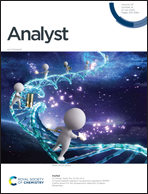Highly efficient peroxidase-like activity of a metal–oxide-incorporated CeO2–MIL(Fe) metal–organic framework and its application in the colorimetric detection of melamine and mercury ions via induced hydrogen and covalent bonds†
Abstract
The illegal addition of melamine to dairy products and the contamination of water with mercury (Hg2+) are serious threats to human health. Hence, herein, a highly sensitive colorimetric sensor for the visual detection of melamine and Hg2+ ions has been developed using a metal–oxide-in-MOF nanomaterial (CeO2–MIL (Fe)) as a peroxidase mimic. Highly mono-dispersed CeO2–MIL (Fe) was synthesised via a facile hydrothermal process. The CeO2–MIL (Fe) exhibited outstanding peroxidase activity, and can catalyze the oxidation of TMB (3,3′,5,5′-tetramethylbenzidine) by H2O2, resulting in the development of blue-coloured oxidation products within 5 min. In the presence of melamine, the H2O2 interacts with melamine to form melamine–H2O2via H-bonding. Due to the uptake of H2O2 by melamine, the catalytic oxidation reaction was halted, and the blue TMB oxidation product became pale. The relative change in the absorption intensity at 652 nm was proportional to the concentration of melamine in the linear range of 0–0.1 μM and the detection limit was found to be 8 nM. Subsequently, when Hg2+ ions were added to the above solution, the Hg2+ ions reacted with melamine via strong covalent bonding to form a Hg2+–melamine covalent complex, causing the release of H2O2, which again strongly oxidised the TMB to give the blue-coloured oxidation product. Furthermore, the comparative change in the absorption intensity at 652 nm was dependent on the concentration of Hg2+ ions in the linear range of 0–6 nM, and a detection limit of 2 nM was achieved. The suggested system has several advantages including greater simplicity, good selectivity, naked-eye detection and cost-effectiveness without using any complicated detection procedure. This technique was successfully utilized to identify melamine in real foods and Hg2+ ions in real water samples, yielding high recovery rates.

- This article is part of the themed collection: Analyst HOT Articles 2022


 Please wait while we load your content...
Please wait while we load your content...